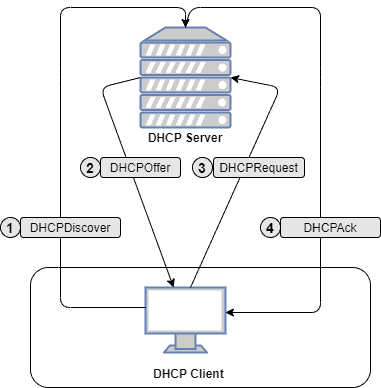1. 引言
DHCP(Dynamic Host Configuration Protocol,动态主机配置协议)是一种基于客户端-服务器架构的网络协议,用于自动为设备分配 IP 地址及其他网络配置信息。
在本教程中,我们将介绍 DHCP 的基本概念、工作原理以及它所带来的优势。适合有一定网络基础的开发者或运维人员参考。
2. 什么是 DHCP?
在 TCP/IP 网络中,每台设备要与其他设备通信都必须拥有一个 IP 地址。IP 地址是网络中设备的唯一标识符。
IP 地址的分配方式通常分为两种:
- 静态分配(Static IP):由用户手动配置,适用于服务器等需要固定地址的场景。
- 动态分配(Dynamic IP):通过 DHCP 自动分配,适用于大多数普通终端设备。
使用 DHCP 可以避免手动配置的繁琐和出错风险。它不仅能分配 IP 地址,还能提供子网掩码、默认网关、DNS 服务器等关键网络参数。
3. DHCP 的工作原理
DHCP 是一种客户端-服务端协议。每台设备连接网络时,会运行 DHCP 客户端,向网络中发送请求;DHCP 服务器则负责响应请求并分配地址信息。
网络中 DHCP 的工作流程如下图所示:

整个过程通常分为四个阶段:
DHCP Discover(发现阶段)
设备首次接入网络时,会广播一个 DHCP Discover 报文,寻找可用的 DHCP 服务器。DHCP Offer(提供阶段)
DHCP 服务器收到请求后,从地址池中选择一个可用 IP 地址,通过 DHCP Offer 报文发送给客户端。DHCP Request(请求阶段)
客户端收到 Offer 后,向服务器发送 DHCP Request 报文,正式请求使用该 IP 地址。DHCP Ack(确认阶段)
服务器收到请求后,返回 DHCP Ack 报文,确认 IP 地址、子网掩码、默认网关、DNS 服务器等信息。
✅ 这个四步流程确保了设备能快速、准确地获取到网络配置信息。
4. DHCP 地址租期管理
通过 DHCP 分配的 IP 地址是有使用期限的,这个期限被称为“地址租期(Lease Time)”。
当租期到期后,设备将无法继续使用该 IP 地址,除非重新发起续约请求。为了避免因服务器不可用导致的断网,设备通常会在租期过半时就发起续约请求。
这种机制确保了即使服务器暂时不可用,设备也能在租期结束前获得新的地址,保障网络连接的连续性。
⚠️ 如果租期设置过短,可能导致频繁续约,增加网络负载;过长则可能造成地址浪费。
5. DHCP 的优势
相比手动配置 IP 地址,DHCP 具有以下显著优势:
- ✅ 减少配置错误:如手动输入错误、IP 冲突等问题
- ✅ 集中化管理:网络管理员可以通过 DHCP 服务器统一管理 IP 地址池
- ✅ 自动化配置:设备接入网络即可自动获取配置,无需人工干预
- ✅ 资源高效利用:IP 地址可重复使用,提升地址利用率
例如,当某台设备离开网络后,其 IP 地址将被释放并重新分配给新设备,实现动态回收和再利用。
6. 总结
本文介绍了 DHCP 协议的基本概念、工作流程及其核心优势。
我们了解到:
- IP 地址是网络通信的基础
- DHCP 提供了自动分配 IP 的机制
- 工作流程分为 Discover、Offer、Request、Ack 四个阶段
- 地址租期管理保障了网络稳定性
- 使用 DHCP 可以提升配置效率和资源利用率
对于现代网络环境,尤其是大规模终端接入的场景,DHCP 是不可或缺的基础设施之一。合理配置 DHCP 服务,是保障网络稳定与高效运行的关键。